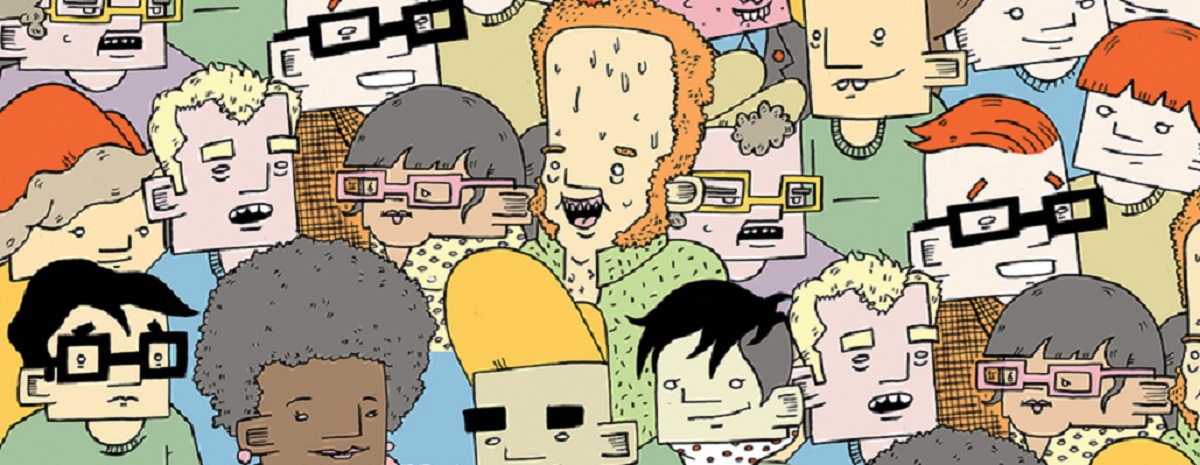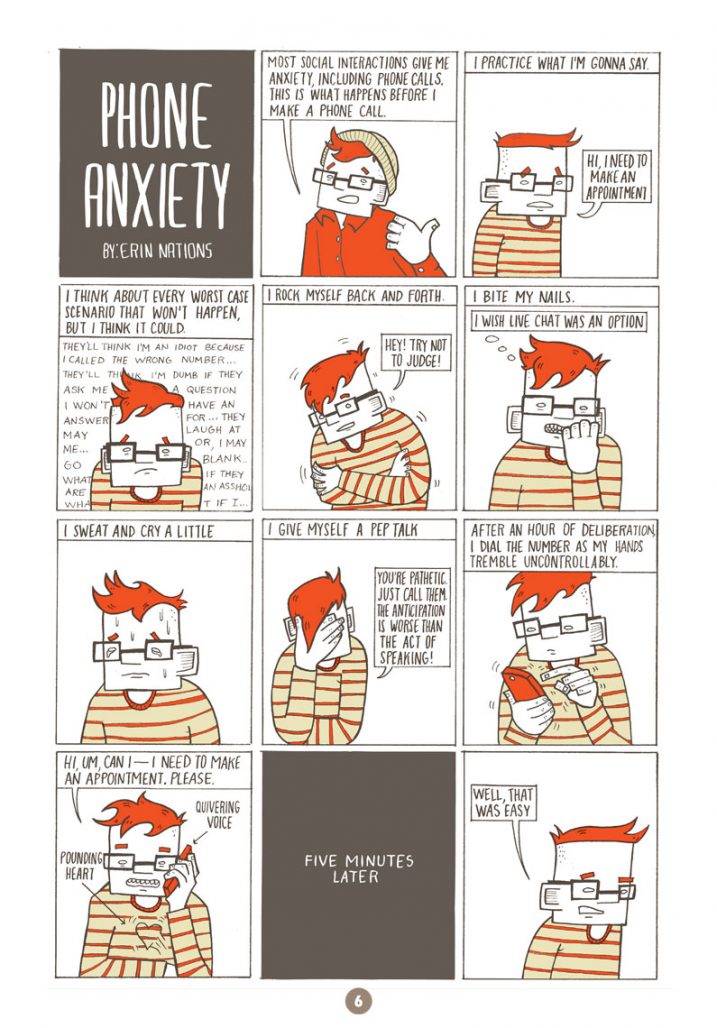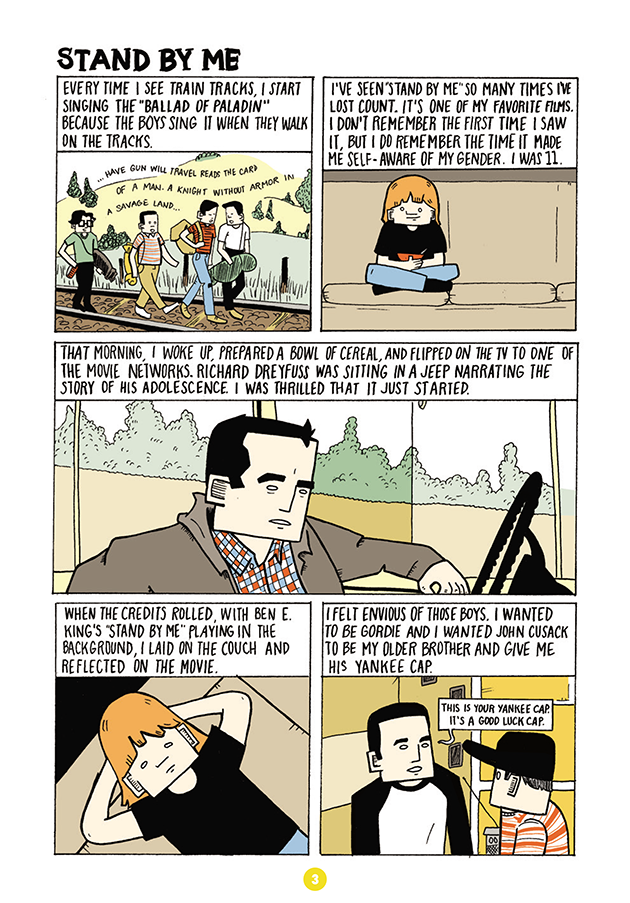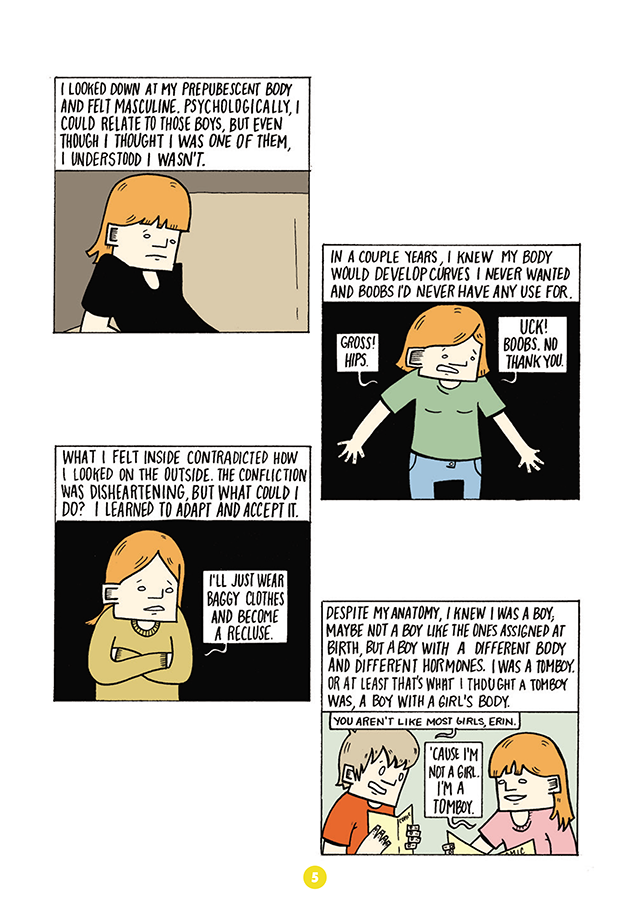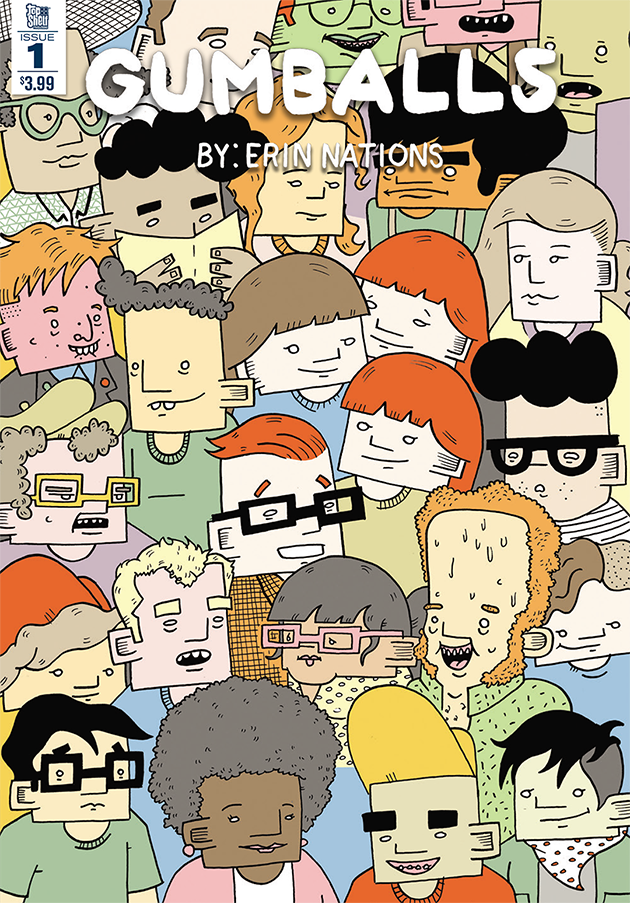
The style that Nations uses and his use of color is striking, but it’s only reading through the book and all of its contents that it becomes clear just how well and how precise an artist Nations is and how he’s able to skillfully utilize this style for a wide range of emotions and approaches. Nations mentions that one of the seminal books of his life was Dan Clowes’ Ghost World, and like that book, Nations is interested in authentic voices, in dialogue, and in presenting individual characters in a unique world.
Nations is a contributor to the quarterly comics newspaper Vision Quest and the creator of many comics and zines who has shown his work at various local galleries. Recently, Nations sat down with the Beat to talk about the series in anticipation of the third issue, which comes out August 16th.
Alex Dueben: What is Gumballs?
Erin Nations: It’s a collection of both comics and illustrations. Most of the comics are pretty short and some are serialized. While some of the stories are fictitious, a majority of the material is autobiographical.
Dueben: Why did you decide to make Gumballs as a comic series as opposed to putting together enough material for a larger collection. Was there something about the form and this one person anthology that you really love?
Nations: Creating a quarterly comic book was never something I envisioned. My introduction into comics was through graphic novels, so I always imagined my first published comic would be a graphic novel. Creating a printed quarterly comic, featuring an anthology of work, was an idea Brett Warnock proposed. He was a former teacher of mine and he saw potential in me and provided a lot of guidance and help. He encouraged me to put together a comic book and to send it to publishers. He knew I had enough material. After seeing all the zines and comics I had created, he suggested I compile them into a comic book series. I was open to the idea so I decided to go for it.
Dueben: How much thought did you put into a combination of stories and styles and approaches. Were you conscious of, this book needs to be many things?
Nations: No, I wouldn’t say I was trying to create a book of many things. I think because most of my comics are pretty short and I have 32 pages to fill, I’m able to pack a lot of variety into one issue. Essentially, I was working on a several different on-going comics and I decided to put them all into one book. Readers will notice, that a lot of the stories in issue one will continue to appear in future issues.
I definitely want to incorporate something new in each issue, but for the most part, I want to provide stories that will carry over to the next issue. I like the idea of having something familiar for readers to come back to and/or look forward to in the next issue. However, to break up the monotony, I wanna throw in a few new things that are not reoccurring.
Dueben: Do you have an overall plan for the book. Do you have the next few issues partially or completely done?
Nations: Before I began working on the first issue, I constructed a plan for the book and I thought about the content I’d use. However, I’m sure down the road I’ll want to incorporate new story lines and retire other ones. Some of the comics will become longer. It’s hard to say what is in store for the future, but I think change is inevitable as I evolve as a cartoonist.
Dueben: Are you leaving yourself room to change your mind and do something completely different a couple months down the road?
Nations: The initial plan was pretty concrete. However, with three issues in, I’m already starting to feel the itch to create something new to incorporate. If I feel like something has run its course, or if I think a storyline has reached a conclusion, I plan to end it and start something new. Regardless of when that may happen, I’m sure the transition from one completed story to a new one will be smooth.
Dueben: How did you end up at Top Shelf?
Nations: I was interested in a publisher of alternative comics and Top Shelf was definitely on my list. I enjoy their comics and I thought my work and style fit in with the work they publish, which is important when considering a publisher.
When discussing publishers with Brett, Top Shelf was the first one he mentioned. He is one of the co-founders of Top Shelf and was a former publisher there. He spoke with Chris Staros and showed him some of my work. Chris was intrigued, so I put together the first issue of Gumballs, Brett submitted it to Top Shelf, and I got published.
Dueben: Why is it a quarterly publication?
Nations: It really boils down to time. I’d love to be able to produce something in a shorter time frame, but I have a full time job aside from making comics. I’m hoping, in time, that will change. In the future, I hope to devote more time to comics, but right now I need my other job to pay my bills. I think there is this misconception that once you’re a published cartoonist/author, you’re suddenly making tons of money. That is not the true. At least not for emerging cartoonist.
Dueben: You’ve been making comics for a little now but what made you interested in making comics? What brought you to comics?
Nations: I’ve been drawing cartoons since I was eight. I loved cartoons and spent a lot of time re-drawing my favorite cartoon characters. My dream was to become an animator. Then, when I went off to college and I started reading comic books, I felt inspired to make my own.
What drew me into comics was Ghost World by Daniel Clowes. Visually, I was always attracted to comics. As a kid, I read Charlie Brown and Garfield in the Sunday paper and I loved the comics that appeared in The Simpsons Illustrated magazine. However, I became disinterested in comics as a teenage because I was under the assumption that they were mostly superheroes and that had little appeal to me. When I discovered Ghost World, that introduced me to a genre of comics I never knew existed. I became a fan instantly.
Dueben: I know that you live in Portland – along a few other cartoonists – how do you think the city and the fact that it is this comics and zine hub has shaped you and your work.
Nations: I’m sure the education that’s provided here has helped shape my work. I took a class taught by Brett Warnock at PNCA and a course taught by cartoonist Nicole Georges at the IPRC. I was able to learn how to make a comic book and I learned more about the industry not only through them, but also through their guest speakers. They both invited editors, writers, and cartoonist to speak or teach. At the IPRC, we also learned how to bind books and we practiced lettering, among others things.
Aside from that, apparently zines have impacted my way of creating comics. I love small press publications, and self-published comics, and zines and there is an abundance of it here that I’ve been exposed to. Recently, I was listening to this podcast and the two hosts reviewed Gumballs and one of the guys actually said that my comic book kind of reminded him of a zine. I think that’s probably due to the fact that Gumballs does not follow a traditional comic book format, but I still thought it was an interesting observation.
Dueben: So where can people find you online?
Nations: I’m all over the Internet and most social media platforms (except twitter). My website is www.erinnations.com and people are welcome to follow me on instagram @elnations or tumblr at erin-nations.tumblr.com/
Gumball #3 will be released on August 16th!


